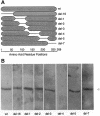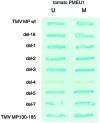Interaction between the tobacco mosaic virus movement protein and host cell pectin methylesterases is required for viral cell-to-cell movement
- PMID: 10698933
- PMCID: PMC305631
- DOI: 10.1093/emboj/19.5.913
Interaction between the tobacco mosaic virus movement protein and host cell pectin methylesterases is required for viral cell-to-cell movement
Abstract
Virus-encoded movement protein (MP) mediates cell-to-cell spread of tobacco mosaic virus (TMV) through plant intercellular connections, the plasmodesmata. The molecular pathway by which TMV MP interacts with the host cell is largely unknown. To understand this process better, a cell wall-associated protein that specifically binds the viral MP was purified from tobacco leaf cell walls and identified as pectin methylesterase (PME). In addition to TMV MP, PME is recognized by MPs of turnip vein clearing virus (TVCV) and cauliflower mosaic virus (CaMV). The use of amino acid deletion mutants of TMV MP showed that its domain was necessary and sufficient for association with PME. Deletion of the PME-binding region resulted in inactivation of TMV cell-to-cell movement.
Figures







References
-
- Atkins D., Hull, R., Wells, B., Roberts, K., Moore, P. and Beachy, R.N. (1991) The tobacco mosaic virus 30 K movement protein in transgenic tobacco plants is localized to plasmodesmata. J. Gen. Virol., 72, 209–211. - PubMed
-
- Bartel P., Chien, C., Sternglanz, R. and Fields, S. (1993) Elimination of false positives that arise in using the two-hybrid system. BioTechniques, 14, 920–924. - PubMed
-
- Citovsky V. and Zambryski, P. (1993) Transport of nucleic acids through membrane channels: Snaking through small holes. Annu. Rev. Microbiol., 47, 167–197. - PubMed
-
- Citovsky V. and Zambryski, P. (1995) Transport of protein–nucleic acid complexes within and between plant cells. Membr. Protein Transp., 1, 39–57.
Publication types
MeSH terms
Substances
Grants and funding
LinkOut - more resources
Full Text Sources
Research Materials

